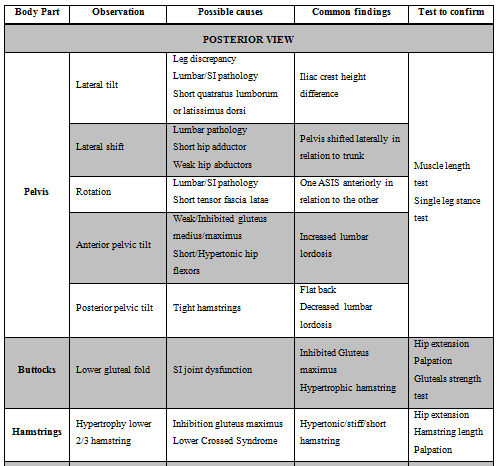Observation
It is fundamental to focus on the cause of the pain rather than treating the symptoms, thus a systematic and detailed evaluation needs to be fulfilled before giving treatment (Page and Frank, 2002). Many faulty postures are described in literature, but in this paper just the hyperlordotic or lower crossed syndrome will be discussed.
First of all, an evaluation of the static posture is essential (Norris, 1995):
Lateral view (Page et al, 1967):
-
Lumbar bodies appear to be anteriorly shifted from the midline
-
Knees are slightly bended and shifted from midline
-
Thoracolumbar kyphosis
Posterior view (Norris, 1995):
-
Notice anatomical landmark difference
-
Notice unequal muscle shape
-
Scoliosis
-
Shoulder height
-
Arm position
-
Position of ASIS and PSIS: lordotic angle is > 50° and sacral angle is > 30° (Magee, 2006)
-
Knees and feet position
Examination
Special Tests
- Thomas test
- Hamstring length
- Hip adductors length
- Trunk Curl-up
- Leg Slide and Leg Lowering tests
- Prone lying hip extension
- Hip abduction
Other possible tests (assess the holding capacity of the muscle synergists) (Norris, 1995)
-
Iliopsoas strength: The patient is seated and attempt to flex the hip, maintaining knee flexion, while the examiner gives resistance.
-
Gluteus maximus strength: The patient is prone with knee flexed at 90°, and the examiner applies resistance to extension movement of the hip.
-
Gluteus medius strength: The patient is side lying with the lowermost leg bent. The upper leg is slightly abducted, extended and lateral rotated. Abduction movement is resisted by the examiner.
Differential Diagnosis (click on the image to see full view)
I
I
I
I
I
I
I
I
I
I
I
I
I
k
